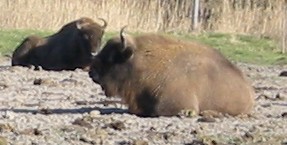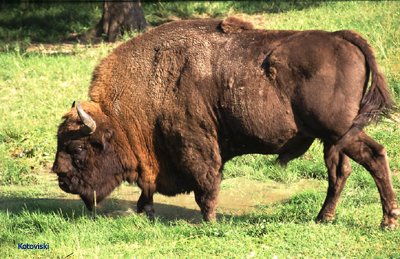Wisent
|
|
| Wisent
Conservation status: Endangered | ||||||||||||||
|---|---|---|---|---|---|---|---|---|---|---|---|---|---|---|
 | ||||||||||||||
| Scientific classification | ||||||||||||||
| ||||||||||||||
| Binomial name | ||||||||||||||
| Bison bonasus (Linnaeus, 1758) |
The Wisent (pronounced 'vE-"zent) is the European bison, species Bison bonasus.
The wisent is Europe's heaviest land animal. A typical individual is about 2.9 m long and 1.8–1.9 m tall, and weighs 300 to 920 kg. It is taller and less massive than its close relation, the American Bison. Their hair on the neck, head, and forequarters is shorter than American bison. Wisent are forest dwelling animals. They have few predators with only scattered reports from the 1800s of wolf and bear predation.
It was first described in scientific literature by Linnaeus in 1758. Some later descriptions treat the wisent as conspecific with the buffalo. It is not to be confused with the aurochs.
| Contents |
Near-extinction
In Western Europe, wisent were gone by the 11th century except in the Ardennes, where they lasted into the 14th century. The last wisent in Romania was killed in 1762 and in Transylvania in 1790.
In the east, wisent were legally the property of the Polish kings, Lithuanian princes and Russian Tsars. King Sigismund the Old instituted the death penalty for poaching a wisent in the mid-1500s. The last wild wisent in Poland was killed in 1919 and the last wild wisent in the world was killed by poachers 1927 in the Caucasus. By that year fewer than 50 remained, all in zoos.
Wisents were re-introduced successfully into the wild beginning in 1951. They are found living free-ranging in forest preserves like Białowieża Forest in Poland and Belarus. Free-ranging herds are found in Poland, Lithuania, Belarus, Ukraine, Russia and Kyrgyzstan. Zoos in 30 countries also have quite a few animals. There were 3000 individuals as of 2000, all descended from only 12 individuals. Because of their limited genetic pool, they are considered highly vulnerable to diseases like foot and mouth disease.
In 1996 the IUCN classified the wisent as endangered.
More details
Wisent have lived as long as 28 years in captivity although in the wild their lifespan is shorter. Productive breeding years are between 4 and 20 years old in females and only between 6 and 12 years old in males. Wisent occupy home ranges of as much as 100 square kilometers and some herds are found to prefer meadows and open areas in forests.
Wisent can cross-breed with American bison. The products of a Nazi interbreeding program were destroyed after the war. This program was related to the impulse which created the Heck cattle. The cross-bred individuals created at other zoos were eliminated from breed books by the 1950s. A Russian back-breeding program resulted in a wild herd of hybrid animals which presently lives in the Caucasian Biosphere Reserve (550 individuals in 1999). There are also Bison-Wisent-Cattle hybrids.
Three sub-species have been identified:
- Bison bonasus bonasus (Linneus, 1758) – (from Białowieża Forest)
- Bison bonasus hungarorum - extinct
- Bison bonasus caucasicus - extinct, although one individual, a bull named Kaukasus was one of the 12 founders of the modern herds
The modern herds are managed as two separate lines -one consisting of only Bison bonasus bonasus (all descended from only 7 animals) and one consisting of all 12 ancestors including the one Bison bonasus caucasicus bull. Only a limited amount of inbreeding depression from the population bottleneck has been found, having a small effect on skeletal growth in cows and a small rise in calf mortality. Genetic variability continues to shrink. From 5 initial bulls, all current wisent bulls have one of only two remaining Y chromosomes.
Trivia
- Wisent, or Zubr in Belarusian (and Russian) is the largest wild animal in Belarus, and it is a national symbol of Belarus today.
- Zubrovka vodka is (indirectly) named after this animal: it is a bitter tincture of the "bison grass".
External link
- Bison entry (http://www.press.jhu.edu/books/walkers_mammals_of_the_world/artiodactyla/artiodactyla.bovidae.bison.html) from Walker's Mammals of the Worldbg:Зубър
da:Europæisk bison de:Wisent nl:Wisent pl:Żubr ro:Zimbru fi:Visentti sv:Visent zh:欧洲野牛

